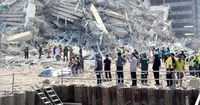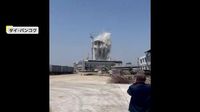A powerful earthquake measuring 7.7 on the Richter scale struck central Myanmar on March 28, 2025, sending strong tremors across the border into Thailand. The quake, which occurred around 1:30 PM local time, was felt most acutely in Bangkok, where a building under construction collapsed, leading to at least two fatalities and numerous injuries.
According to the Associated Press, the collapse of the 30-story building in the Thai capital trapped many workers beneath the rubble. Rescue operations are ongoing, with the Thai National Institute for Emergency Medicine reporting that 43 workers were initially trapped, though many have since been rescued. Eyewitness accounts from the scene describe a chaotic environment with debris scattered everywhere and emergency responders working tirelessly to reach those trapped.
"I was in a restaurant on the sixth floor of a shopping mall when the earthquake hit," said a local reporter, recounting the moment the tremors began. "At first, I thought I was just feeling dizzy, but then the shaking intensified, and it became clear that we were experiencing an earthquake." As people evacuated from the building, fragments of walls fell around them, adding to the panic.
In the immediate aftermath, many residents took to the streets, gathering in parking lots and sidewalks, visibly anxious about the aftershocks. A 34-year-old woman, who went to pick up her child from kindergarten, noted that her child was terrified and crying, unable to return to their 32-story apartment building due to safety concerns. Schools across Bangkok were closed as a precaution.
The earthquake was particularly notable for its long-period seismic waves, which are known to affect high-rise structures. These waves can cause buildings to sway significantly, which was evident as water splashed out of pools on upper floors of skyscrapers throughout Bangkok. Experts suggest that the earthquake's shallow depth and magnitude contributed to the intensity of these waves.
Local media reported that many residents in Bangkok were experiencing their first earthquake, as the city is not typically prone to seismic activity. Kazue Sakurada, a Bangkok resident, described her experience, stating, "Initially, I thought I was dizzy, but then the shaking became intense. Many people around me were panicking, some crying, as the tremors continued."
Despite the chaos, Sakurada noted that, in her immediate vicinity, there were no visible building collapses. However, the streets were congested with traffic as public transportation halted completely, leaving many stranded and anxious.
As rescue efforts continued, the Japanese Embassy in Thailand confirmed that no Japanese citizens had been reported injured in the aftermath of the earthquake. This news provided some relief to the expatriate community, which had been on high alert following the seismic event.
Reports from various eyewitnesses painted a picture of a city in shock. Many described the scene as surreal, with people evacuating from high-rise buildings and gathering outside, unsure of what to do next. A 55-year-old restaurant worker recounted how he immediately stopped cooking and fled outside when the tremors began, relieved that no customers were injured.
As the situation unfolded, the Thai government and emergency services were quick to mobilize resources to assist those affected. The chaotic scenes at the collapse site highlighted the urgent need for effective rescue operations and the importance of building safety regulations, particularly in a city with many high-rise structures.
While the immediate impacts of the earthquake were severe, experts emphasized the need for preparedness in the region, which may not experience frequent earthquakes but is still susceptible to seismic events due to its geographical location. The long-period ground motion caused by this quake serves as a reminder of the potential risks associated with large-scale seismic activity.
In the days following the earthquake, authorities will likely conduct thorough assessments of the damage and implement measures to prevent similar tragedies in the future. As the community begins to recover, the resilience of Bangkok's residents will be tested, but the support from local and international agencies will play a crucial role in their recovery.
The events of March 28, 2025, will be remembered as a significant moment for both Myanmar and Thailand, prompting discussions about earthquake preparedness and building safety standards in a region where such occurrences are rare but devastating.










